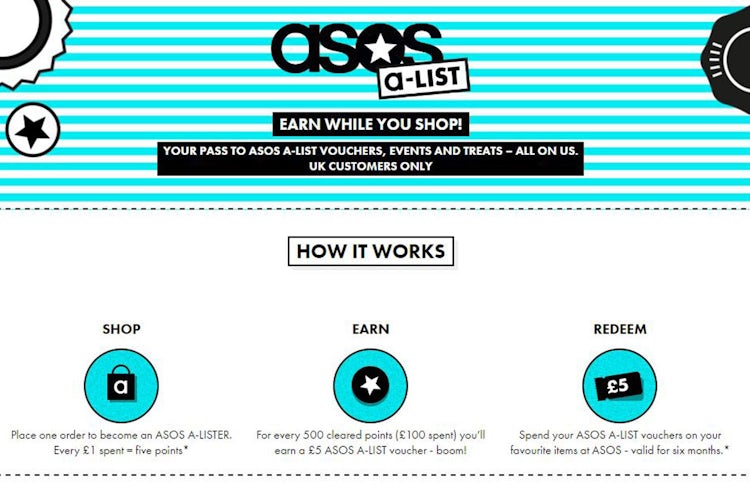Asos A-List’s failure shows you don’t need a loyalty scheme to drive loyalty
A-List didn’t fail because it was a Z-List scheme, rather it shows online-only retailers can engender customer loyalty with a focus on customer experience, rather than rewards.

Asos is pulling the plug on its A-List loyalty programme today, taking a £2.7m write-down on the three-year-old scheme.
The online retailer says it is a necessary move so it can “get to work on even better ways to reward our loyal customers” and at a more global scale. What that actually means remains shrouded in typical Asos mystery, although it wouldn’t come as a surprise if it involves its wildly popular Premier delivery offer.
A-List worked a bit like Boots’s Advantage card but with added tiers. Five points for every pound spent, one pound credit for every 100 points collected (so one pound back for every £20 spent). The more points you got, the higher the tier you could enter, with each level giving access to greater rewards including discounts, entry to competitions, prize draws and bonus points days.
It sounds like a pretty decent value exchange and yet Asos says only a small number of people “absolutely engaged” with A-List. So why, amid all this talk of how valuable loyalty schemes are to brands, didn’t this one take off?
Young people are notoriously difficult to engage for numerous reasons but the issue here is not that they don’t want brands to offer loyalty programmes.
According to YouGov, 61% of 18- to 24-year-olds are a member of at least one, while 73% think they are a good way for brands to reward customers and 59% think all brands should offer one.
And tier-based schemes can work very well as Sephora’s Beauty Insider loyalty programme and its 10 million members prove. (Earlier this year I said Asos’s A-List has had a “similar success“, but it seems appearances and jazzy emails can be deceiving.)

But with 18.4 million active customers and retail sales up 26% year on year, Asos clearly isn’t struggling to get people to come to the site and dip their hands into their pockets. And for online retailers the benefits of a CRM system are less clear. The advantage for traditional retailers is that they can tie together online and offline sales and get a clearer picture of how customers are behaving. Online-only retailers already have all this data so investing in a costly loyalty programme seems to make less sense.
Offering a great customer experience
Asos is not the only brand grappling with loyalty programmes and experimenting with new ways to boost return visits. New schemes have tried everything from rewarding engagement (think Sainsbury’s) to testing out tenure-based initiatives (as Sky is). But the failure of A-List throws up the wild possibility that perhaps a good customer experience has been the secret ingredient to driving loyalty all along.
That looks to be the case for online-only retailers at least, where the model is built on speed, ease and convenience. For Asos, its USP is without a doubt its premier delivery option, which gives customers a whole year of next-day delivery or nominated-day delivery with no minimum order value for just £9.95. You can order something, try it on and return it within 12 hours.
Let’s face it, most people aren’t buying from fast fashion retailers like Asos, Missguided and Boohoo because they are loyal to the brand. It is the slick customer experience they provide that gets people to shop again and again. Asos Premier is the cherry on top.
This means Asos’s new loyalty scheme will need to offer a better value exchange than its Premier service. So it would make sense to tie the two together. Premier has 1.3 million people signed up and has grown 53% over the last 12 months. This could save Asos a lot of time and money than if it were to start with an entirely blank slate. (It has even given its A-Listers a £10 voucher as a thank you, which Asos subtly suggests can be used to buy Premier Delivery…and give Asos even more data on its lost loyalty members.)
It is surely only a matter of time until Missguided, Boohoo and other fast fashion retailers follow suit. But there is a much bigger question yet to be answered: can these retailers keep people loyal in the long-run?
As consumers become more clued up about sustainability and supply chain ethics, it feels like good customer experience will only go so far before the numbers and sales start to drop off. This means these pure-play digital brands are going to need to do much more, and starting soon, if they are to turn the lure of good customer experience into genuine, long-term loyalty.
And it’s probably going to need to go beyond points, perks and tiers, as A-List proves. The question is whether these retailers can deliver a solution as quickly as they can a pair of jeans.






